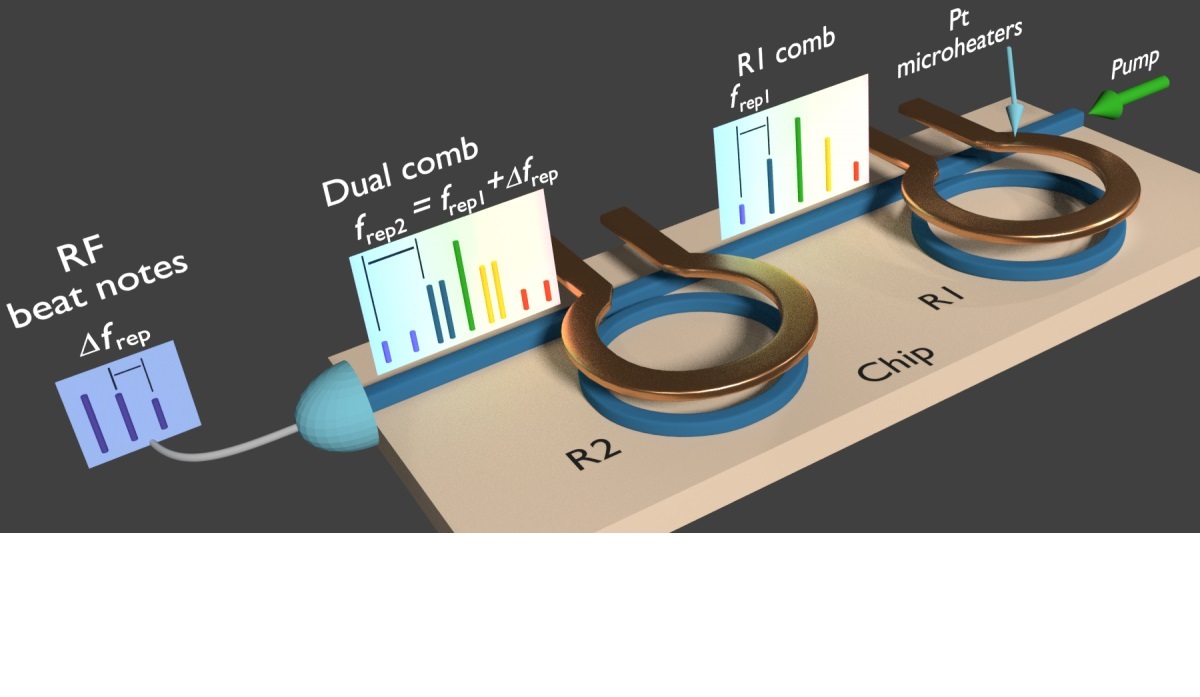New York, NY—March 2, 2018—In a new paper published today in Science Advances, researchers under the direction of Columbia Engineering Professors Michal Lipson and Alexander Gaeta (Applied Physics and Applied Mathematics) have miniaturized dual-frequency combs by putting two frequency comb generators on a single millimeter-sized chip.
“This is the first time a dual comb has been generated on a single chip using a single laser,” says Lipson, Higgins Professor of Electrical Engineering.
A frequency comb is a special kind of light beam with many different frequencies, or “colors," all spaced from each other in an extremely precise way. When this many-color light is sent through a chemical specimen, some colors are absorbed by the specimen's molecules. By looking at which colors have been absorbed, one can uniquely identify the molecules in the specimen with high precision. This technique, known as frequency-comb spectroscopy, enables molecular fingerprinting and can be used to detect toxic chemicals in industrial areas, to implement occupational safety controls, or to monitor the environment.
“Dual-comb spectroscopy is this technique put on steroids,” says Avik Dutt, former student in Lipson’s group (now a postdoctoral scholar at Stanford) and lead author of the paper. “By mixing two frequency combs instead of a single comb, we can increase the speed at which measurement are made by thousandfolds or more.”
The work also demonstrated the broadest frequency span of any on-chip dual comb—i.e., the difference between the colors on the low-frequency end and the high-frequency end is the largest. This span enables a larger variety of chemicals to be detected with the same device, and also makes it easier to uniquely identify the molecules: the broader the range of colors in the comb, the broader the diversity of molecules that can see the colors.
Conventional dual-comb spectrometers, which have been introduced over the last decade, are bulky tabletop instruments, and not portable due to their size, cost, and complexity. In contrast, the Columbia Engineering chip-scale dual comb can easily be carried around and used for sensing and spectroscopy in field environments in real time.
“There is now a path for trying to integrate the entire device into a phone or a wearable device,” says Gaeta, Rickey Professor of Applied Physics and of Materials Science.
The researchers miniaturized the dual comb by putting both frequency comb generators on a single millimeter-sized chip. They also used a single laser to generate both the combs, rather than the two lasers used in conventional dual combs, which reduced the experimental complexity and removed the need for complicated electronics. To produce miniscule rings—tens of micrometers in diameter—that guide and enhance light with ultralow loss, the team used silicon nitride, a glass-like material they have perfected specifically for this purpose. By combining the silicon nitride with platinum heaters, they were able to very finely tune the rings and make them work in tandem with the single input laser.
“Silicon nitride is a widely used material in the silicon-based semiconductor industry that builds computer/smartphone chips,” Lipson notes. “So, by leveraging the capabilities of this mature industry, we can foresee reliable fabrication of these dual comb chips on a massive scale at a low cost.”
Using this dual comb, Lipson’s and Gaeta’s groups demonstrated real-time spectroscopy of the chemical dichloromethane at very high speeds, over a broad frequency range. A widely used organic solvent, dichloromethane is abundant in industrial areas as well as in wetland emissions. The chemical is carcinogenic, and its high volatility poses acute inhalation hazards. Columbia Engineering’s compact, chip-scale dual comb spectrometer was able to measure a broad spectrum of dichloromethane in just 20 microseconds (there are 1,000,000 microseconds in one second), a task that would have taken at least several seconds with conventional spectrometers.
As opposed to most spectrometers, which focus on gas detection, this new, miniaturized spectrometer is especially suited for liquids and solids, which have broader absorption features than gases—the range of frequencies they absorb is more spread out. “That’s what our device is so good at generating,” Gaeta explains. “Our very broad dual combs have a moderate spacing between the successive lines of the frequency comb, as compared to gas spectrometers which can get away with a less broad dual comb but need a fine spacing between the lines of the comb.”
The team is working on broadening the frequency span of the dual combs even further, and on increasing the resolution of the spectrometer by tuning the lines of the comb. In a paper published last November in Optics Letters, Gaeta’s and Lipson’s groups demonstrated some steps towards showing an increased resolution.
“One could also envision integrating the input laser into the chip for further miniaturizing the system, paving the way for commercializing this technology in the future,” says Dutt.
About the Study
The study is titled “On-chip dual comb source for spectroscopy.”
Authors are: Avik Dutt, Chaitanya Joshi, and Xingchen Ji (Columbia Engineering and Cornell University); Jaime Cardenas (Columbia Engineering, now at University of Rochester); Kevin Luke (Cornell University); Yoshitomo Okawachi, Alexander L. Gaeta, and Michal Lipson (Columbia Engineering).
The study was funded bythe Defense Advanced Research Projects Agency (N66001-16-1-4052, W31P4Q-15-1-0015) and the Air Force Office of Scientific Research (FA9550-15-1-0303). The chips were fabricated at the Cornell Nanoscale Facility.
The authors declare that they have no competing interests.














